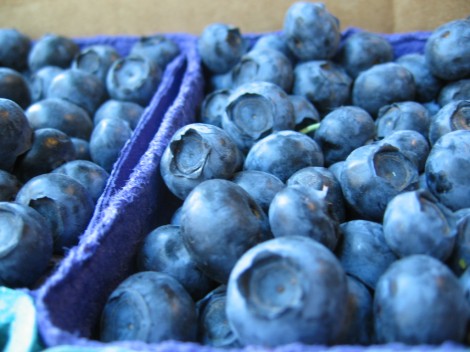
Blueberry cultivation is an intricate but fulfilling hobby. There are many varieties of blueberries to choose from. The type chosen depends on the region as well as the intended use after. There are three distinct types: High bush, semi-high bush and low bush. Whichever variety you choose, it is recommended that you plant at least two or more varieties that ripen at different times to give you maximum yield over the harvest season. This is especially important for many commercial growers, but can be also be implemented in your home garden.
Pollination
While blueberries are capable of producing fruits without the need for cross-pollination, there have been studies that show larger, earlier ripening fruits can be obtained from pollination between varieties. Multiple variety plantings often yield more fruits in a smaller garden than a huge one variety garden. Pollination of course, does not happen without the help of bees.

Bees do not prefer temperatures cooler than 55 degrees F. Windy or rainy weather are also not their favorite weather to be in. You will really need to time your planting to coincide with optimal conditions for bees to emerge and help you cross-pollinate if you wish to have larger varieties.
To encourage the bees to pollinate, remove any competing plants such as other flowering plants and weeds like jasmine, shrubs and grasses so that the bees will concentrate solely on the blueberry plants. You may want to build a bee block as a new home for bees to start a colony, so that they will not dwell far from your garden to the blueberries. Trees that are bare, including rotting woods, twigs and high grasses, are also place where bee colonies can form hives. Read and know about how bees behave and arm yourself with lots of information especially when you going to start a bee colony in your back garden.
Alternatively, if bees aren\’t an option, applications of gibberellic acid made at late bloom may increase fruit-set.
Soil Requirements
Blueberries are very finicky when it comes to soil requirements. The soil should be high organic matter which helps in water retention and improve the aeration of the soil. This is because blueberries have very sensitive roots that don\’t survive well with soil compaction and poor drainage. The ideal soils for blueberries are well drained soil with a water table 14 to 22 inches below the surface. The bottom line here is to avoid planting blueberries on heavy soils that drain slowly. Adding peat, bark mulch or straw is the ideal way to increase organic matter in your home garden.
To ensure a more uniformed supply of moisture to the soil without causing water to stand or too dry a surface soil, consider installing a drip irrigation system. This is especially useful if your garden is of sandy soils which are low in organic matter and water retention capability.
Blueberries can grow in soil with pH value below 5.5, and thrive between 4.5 and 5.0. Run a soil test before you start planting the blueberries. (Refer to chapter of Soil Test). Once you\’ve done this, make the required amendments to the soil and allow it to rest over a season (preferably winter). Then test it again to make sure that you\’ve obtained the soil requirements that will help your plant thrive.
Planting Your Blueberry Shrubs
Blueberry planting varies among the variety, type and age of the plants, as well as the region you live in. Plant spacing and root system placement is important when establishing the blueberry plants in the home garden.
For highbush and midhigh blueberries remove all the flowers in the first two years after initial planting to allow them to concentrate energy and nutrients to strengthening roots and shoots. Fertilize the blueberries each spring and apply mulch such as oak leaves, woodchip or pine needles to a depth of 1 to 2 inches. This protects the bushes shallow roots. Water the plant regularly.
Protect you plant from birds (who would love blueberries just as much as you would) with netting. If you have a small patch to work on, using stucco wire cage for each bush may be easier especially over harvest season. Encircle the plant with the wire cage and cover the top of the cage with netting. This can also be done with wood or plastic plumbing pipe.
Prune the bushes only after they\’ve established themselves well to increase productivity. Do not prune young bushes. Wait until the plants are three years old and prune in late winter or early spring just before growth begins each year. Approximately two to four years after planting, the fruits will emerge.
Blueberries are a great addition to a home garden. They provide you with a burst of scarlet color in the fall and provide you with a harvest of mouth watering berries in summer.
More Reading:
Growing Blueberries: Tips on How to Grow Blueberries:
http://howtogardenguide.com/2008/02/22/grow-blueberries/
Growing Blueberries: http://www.farminfo.org/orchard/blueberry.htm
Hints on Growing Blueberries: http://www.canr.msu.edu/vanburen/e-2066.htm
Spacing Plants and Root Systems:
http://www.doityourself.com/stry/blueberry-planting-spacing-plants-and-root-systems
Blueberry Picking Tips and Guidelines:
http://www.doityourself.com/stry/blueberry-picking-tips-and-guidelines
Blueberry Cultivation: Pollination and Cross-Pollination:
http://www.doityourself.com/stry/blueberry-cultivation-pollination-and-crosspollination
Blueberry Plants and Soil pH:
http://www.doityourself.com/stry/blueberry-plants-and-soil-ph
Blueberry Varieties: The Best Type For Your Climate:
http://www.doityourself.com/stry/blueberry-varieties-the-best-type-for-your-climate

